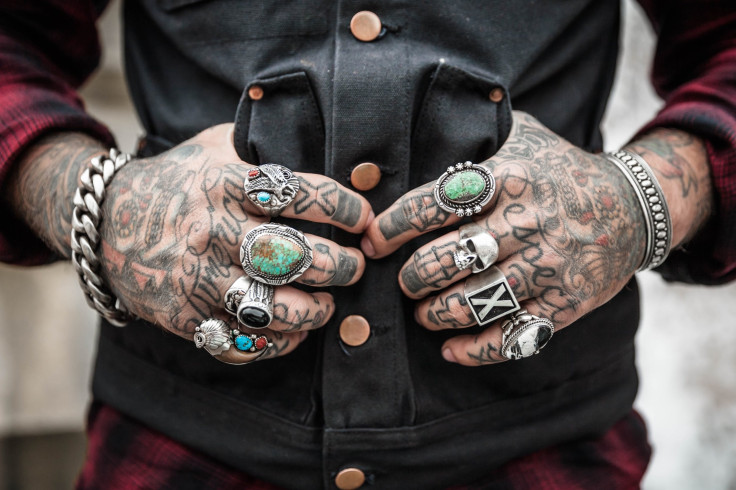Getting A Tattoo May Change Your Body Sweat During Intense Exercise

Many people hate working out because they don't like to sweat. But, our sweat glands actually work to cool off the body and purify our pores so we don't overheat. Now, a recent study published in Medicine and Science in Sports and Exercise suggests getting tattoos could permanently change the way our body sweats, especially during intense exercise.
Researchers at Alma College in Alma, Michigan found people tend to perspire differently depending on whether they have tattoos or not. For example, volunteers with tattooed skin produced barely half as much sweat as the un-inked. Moreover, the perspiration from the tattooed skin contained nearly twice as much sodium as sweat from the untattooed side.
Read More: Tattoos And Health 2016: Questions To Ask Before You Get Inked
The age of the tattoos were irrelevant. Skin with older tattoos sweated the same way skin with new tattoos did. The researchers believe the sweat difference could be due to the permanent changes that occur within the skin after getting inked.
When getting a tattoo, the artist will puncture the epidermis — the outside layer of the skin — with dye-filled needles at about 50 to 3,000 times a minute. The needle then enters the layer beneath known as the dermis, where most sweat glands are located; here, capillaries take the ink down from the holes in the epidermis. At first, the body will see these injections as abnormal, so the immune system tries to "save the body" from all the wounds caused by the needle.
Tattoos can inhibit the ability to sweat, which could be a problem for an athlete, a firefighter or a marathon runner in a hot climate. For example, people in hot areas may be sweating at their maximum, but if they lose the ability to sweat through the inked part of their skin, they will have a lower maximum, and could potentially overheat, because they're not producing enough sweat to cool off.
“It is certainly very conceivable that tattoos impair local sweating responses, but the overall impact will be determined by the proportion of surface area covered by tattoos,” Dr. Ollie Jay, a professor of thermoregulatory physiology at the University of Sydney, unrelated to the study, told Healthline.
Moreover, it is not known if a mechanism of compensatory sweating in non-tattooed areas exists to make up for the lower sweating on the tattooed area.
The research team, led by Maurie Luetkemeier, a professor of integrative physiology and health science at Alma College, sought to observe the effects of tattoos on sweating by recruiting 10 healthy, young men with a tattoo on one side of their upper bodies. This tattoo had to be matched with an equal amount of untattooed skin on the other side. In other words, a tattoo on your right bicep would be balanced by no tattoo on the same side on the left bicep.
To measure sweat, the researchers used chemical patches containing pilocarpine nitrate — a substance that induces sweating — to stimulate sweating on both the tattooed skin and untattooed skin. Following pilocarpine, the patches were changed for small spiral-shape discs designed to absorb the total perspiration. The participants wore these discs for 20 minutes as their skin was sweating.
Read More: Man Dies From Flesh-Eating Bacteria After Swimming In Gulf Of Mexico With New Tattoo
Overall, the findings suggest sweat production is about half in tattooed skin compared to untattooed skin. The researchers theorize perhaps the tattooing process could interfere with sweat functions since the needle enters the dermis, where most sweat glands are found. But, further research is needed to determine if this effect occurs when people exercise.
It's important to note this is a small study that involved chemically induced perspiration. The sample size was limited and there were no women or elderly people. A bigger group focusing on more real-world situations could investigate whether these results could be replicated.
This could have implications on athletes who tend to have more tattoos than the average American. For example, over half of active NBA players have tattoos, while about 30 percent of the general population does. Tattoos could potentially hinder athletic performance if they interfere with sweat glands.
Until further research is done, tattoos should not be a cause for concern. But, it does introduce a possibility that's worth delving skin deep into.
Source: Luetkemeier MJ, Hanisko JM, and Aho KM. Skin Tattoos Alter Sweat Rate and Na+ Concentration. Med Sci Sports Exerc. 2017.
See Also:
Tattoo Artist Uses Ink As Permanent Makeup For Burn Victims
Vinnie Myers Creates 3D Nipple Tattoos To Help Breast Cancer Survivors Return To Normalcy
Published by Medicaldaily.com



























